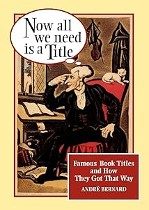 André Bernard •
André Bernard •
Now All We Need Is a Title •
If you’re a mystery buff, you’ve probably faced this situation: You buy a book by one of your favorite writers, only to find you already have a copy at home. The prolific John D. MacDonald sought to address this by including a color in the title of each of his mysteries, reasoning that you would remember a color even if you forgot the rest of a title. His Travis McGee series launched in 1964 with The Deep Blue Good-by, and MacDonald never looked back.
Best-selling author Sue Grafton took inspiration from Edward Gorey
when choosing a name for her debut crime novel. She had come across Gorey’s “Gashlycrumb Tinies,” cheerfully describing the gruesome deaths of 26 children, from Amy (fell down the stairs) to Zillah (drank too much gin). You can almost see the lightbulb coming on over Grafton’s head as she scribbles A Is for Alibi on that first manuscript.
Where did the title Light in August come from? A chance remark by William Faulkner’s wife. A Streetcar Named Desire? An actual streetcar line that terminated at Desire Street in New Orleans (crossing the Cemeteries line). The Postman Always Rings Twice? That’s what he did, when James M. Cain’s mail contained only bills or rejected manuscripts.
Now All We Need Is a Title is chockablock with behind-the-scenes title stories like these, interspersed with related anecdotes from the world of books. My favorite concerns the publisher who decided to give away Band-Aids as a promotional gimmick for a children’s book called Dr. Dan the Bandage Man. He placed an order with Johnson & Johnson for 2 million Band-Aids to be shipped as soon as possible—and got back a telegram reading BAND-AIDS ON THEIR WAY. WHAT THE HELL HAPPENED TO YOU?







Your email address will not be published.